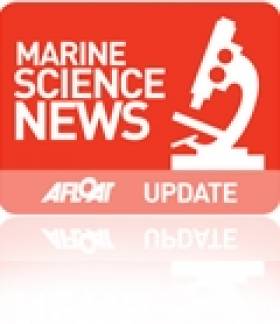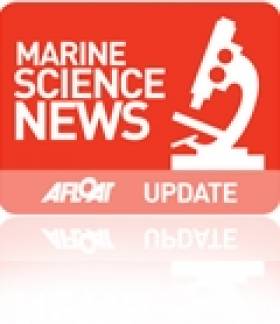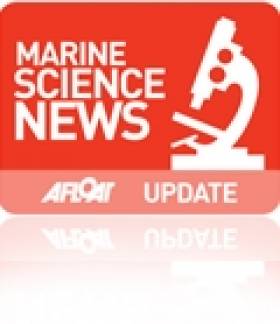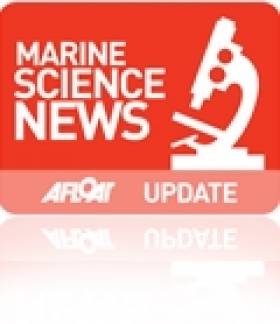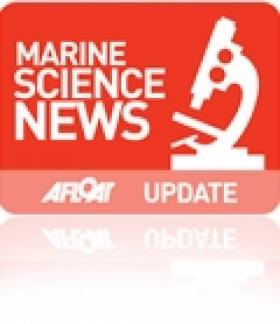Displaying items by tag: marine science
SmartOcean's Call of the Sea for Emerging Marine Tech Opportunities
SmartOcean Ireland invites ICT companies to register for the SmartOcean Forum 2013 at the Titanic Centre, Belfast, 5-6 November and join Ireland's emerging marine technology sector to develop high-tech products and services for the global marine sector.
The purpose of this all-island event is to highlight the commercial opportunities and emerging innovations of Ireland's SmartOcean Cluster. The forum, sponsored by Invest Northern Ireland, will focus on key areas such as blue growth, marine data and knowledge, renewable ocean energy, sustainable exploitation of marine resources and ocean observation.
SmartOcean, a Marine Institute led initiative, aims to establish Ireland as a leader in the development of specialist ICT products and services for global marine sectors.
Dr. Edel O'Connor, National Coordinator, Advanced Marine Technology Programme said: "We have a huge opportunity here in Ireland to translate technologies for global marine markets including traditional sectors such as fisheries, aquaculture, transport and security as well as emerging sectors such as ocean energy and environmental monitoring, and ocean observatories. We want to bring together ICT companies, large and small, in Ireland, the European Atlantic States, the US and Canada to collaborate and deliver new marine technology products and services."
Alison Gowdy, Head of Sector and Cluster Development at economic development agency Invest Northern Ireland, commented "ICT companies in Northern Ireland are enjoying global success in many areas relevant to the SmartOcean event, including wireless sensors, data analytics, mobile and wireless comms, and underwater monitoring. Invest Northern Ireland is pleased to sponsor the event which is being held in Belfast this year for the first time".
The forum will have a strong transatlantic focus building on the Galway Statement on Atlantic Ocean Cooperation signed earlier this year (23 May 2013) at the Marine Institute by EU Commissioners Maire Geoghegan Quinn and Maria Damanaki, Edward Fast for Canada and Dr Kerri-Ann Jones on behalf of the US Government.
Speakers from US, Canada, and Europe will include Dr. Gilles Ollier, Head of Sector Earth Observation, DG for Research & Innovation, European Commission, Dan Fay, Director, Earth, Energy and Environment, Microsoft Research, and Andrei Grigoriev, Senior Director Enterprise Services SAP as well as the European Space Agency,
The forum will give insights on emerging markets, policy and opportunities for innovation associated with the launch of Horizon 2020 in 2014 and will work towards achieving targets set out in Harnessing Our Ocean Wealth – An Integrated Marine Plan for Ireland.
For more information and registration visit www.smartocean.org
Register For SMARTSkills Workshop On Research Funding And Marine Data
#MarineScience - The SMARTSkills 2013 Postgraduate Workshop on Research Funding Opportunities and Marine Data Access will be held on the 24 and 25 October 2013 hosted by the Marine Institute in Oranmore, Galway.
The two-day workshop is organised by the Strategic Marine Alliance for Research and Training (SMART) and is sponsored by Galway-Mayo Institute of Technology (GMIT), and aims to support postgraduate researchers by providing practical, concise information on accessing research funding and marine data sets, two topics identified as essential for emerging marine researchers.
Day one of the workshop will focus on funding mechanisms, researcher mobility, careers and access to infrastructure and training.
Speakers are drawn from a wide range of scholarship and research organisations including the Higher Education Authority, Erasmus Mundus, AquaTT, Science Foundation Ireland, Irish University Association, Enterprise Ireland, Marie Curie, Euraxess, European Research Council and UCD Innovation Academy, along with a number of research funding programmes including Horizon 2020 and Interreg V.
The second day will address how to access and mine the huge variety of marine biological, oceanographic, environmental and ocean energy-related datasets and model outputs available.
National and International marine data experts will present on online data portals and datasets including SeaDataNet, My Ocean, PlanktonNet, EMODNet, INFOMAR, MIDA, ICAN and ICES. The topic of data management will also be examined with a focus on formatting, metadata and archiving data.
SMARTSkills will also serve as a networking and social opportunity and facilitate marine researchers in communicating their research with potential future collaborations. All attendees are therefore also requested to give a two-minute flash presentation on their research.
The workshop is open to all postgraduate students of marine science, technology and engineering from across the island of Ireland.
The SMART postgraduate workshop is free to students from all member institutes. A registration fee of €75 is payable by students from institutes not involved with the SMART consortium, although some scholarships are available.
SMART partners include: Athlone Institute of Technology (AIT); Galway Mayo Institute of technology (GMIT); Marine Institute (MI); NUI Galway (NUIG); University College Cork (UCC) and University of Ulster (UU).
All prospective attendees register online before tomorrow Friday 18 October. Registration and further information is available HERE. For any further queries contact the SMART team at [email protected].
#MarineScience - The RV Celtic Explorer is nearly a week into its Celtic Sea Herring Survey for 2013 with a wide variety of marine wildlife sightings already on record.
Some 15 scientists comprise the crew of the research vessel for the 3,200-nautical-mile voyage, including eight members of the core acoustic and biological team, plus four seabird observers, one marine mammal observer, one observer from the fishing industry and a PhD student in environmental microplastics.
The boat's first day at sea saw the crew treated to the sight of more than 50 common dolphins around the Blasket Islands and Dingle Bay, which also boasts an important concentration of seabird species such as sooty shearwaters, guillemots and storm petrels.
The latter, also known as 'stormies', are one of the hardiest bird species, especially for their tiny size - many living for up to 30 years despite the challenging conditions the face far out to sea on their migratory path to south-west Africa.
But herring stocks are the focus of this survey, and where there's herring there are whales - with multiple fin whales and at least one humpback whale spotted south of Union Hall last Thursday 10 October.
For more updates from the Celtic Explorer crew follow their Scientists@Sea blog HERE.
Seabed Survey Seminar Tries To Bridge Gap Between Research And Industr
#INFOMAR - The annual INFOMAR Seminar on one of the world’s largest seabed mapping programmes took place this week at the University of Limerick from 9-10 October, with updates on Ireland’s national seabed mapping programme.
Archie Donovan of the Geological Survey of Ireland highlighted INFOMAR’s recent mapping achievements saying: “We have made significant progress towards the delivery of national targets identified in our national integrated marine plan, Harnessing Our Ocean Wealth, and supporting ocean energy, marine tourism, environment, and shipping and trade development and management.”
A key focus of the conference is to bridge the gap between research and industry and the potential for innovation, research, and business opportunities from the mapping data and activities.
Among the SMEs presenting their innovations in this area were Gavin Duffy of RealSim Ltd, who presented their mapping and visualisation technology, and Francis Flannery of SonarSim Ltd who spoke about the benefits of multidisciplinary research collaboration from an SME perspective.
“There are significant scalable commercial opportunities relating to INFOMAR supported technology outputs, linking industry needs to research applicationsm," said the Marine Institute's Tommy Furey.
"The programme has already generated industry partnerships, for example, Geomar and Highland Geosolutions, and there are global opportunities for Ireland to deliver marine technology solutions, leveraging the internationally recognised INFOMAR brand."
A session on ‘Mapping Requirements & Mapping Technologies’ included a presentation on the need for mapping of Ireland’s vast and valuable seaweed resources by Dagmar Stengel of NUI Galway.
Tim McCarthy of NUI Maynooth examined the use of unmanned autonomous vehicles in seabed mapping as well as the challenges that brings.
The seminar hosted by the Mobile & Marine Robotics Research Centre included a presentation by Dr Andy Wheeler of UCC about the Moytirra Vent, a new type of hydrothermal vent, discovered onboard the national research RV Celtic Explorer in 2011 by a team of Irish and international scientists.
There was also an update on the mapping of shipwrecks and collaboration between the Underwater Archaeology Unit and the INFOMAR Programme, as well as a look at the investigation of INFOMAR-mapped shipwrecks by divers on the North Coast of Ireland.
INFOMAR is a joint venture between the Geological Survey of Ireland and the Marine Institute, and follows on from the Irish National Seabed Survey.
Covering some 125,000 sq km of Ireland's most productive and commercially valuable inshore waters, INFOMAR will produce integrated mapping products covering the physical, chemical and biological features of the seabed, and has prioritised the surveying of 26 bays and three priority areas around the coast of Ireland.
For more information visit www.infomar.ie
Inland Fisheries Ireland Extends Research Partnership With UCD
#MarineScience - Inland Fisheries Ireland (IFI) and University College Dublin (UCD) jointly sealed a Memorandum of Understanding at UCD’s Ardmore House on Monday 7 October expressing their commitment to a continued rich and productive liaison in research.
Over the past 50 years, scientists from UCD and the fisheries service have worked in collaboration in producing research that has covered an extraordinary range of projects – from aquatic plant to macro-invertebrate and fish stock studies.
In recent years the boundaries have expanded even further with collaborative micro-satellite DNA studies of fish stocks being undertaken.
“With the current limited public purse, this agreement will ensure a greater degree of symbiosis between these two organisations resulting in increased productivity, avoidance of duplication and strategically focused research,” said Minister of State Fergus O’Dowd, who presented both bodies with commemorative plaques to mark the occasion.
“It is my hope that this academic research, when coupled with applied research and practical application, will serve to increase our understanding on the inland fisheries resource though the use of novel technologies like DNA, environmental DNA and the development of bio-controls.”
The minister went on to stress the importance of the MOU in providing graduates and postgraduate with exposure to applied science and an opportunity to contribute to our understanding of the freshwater resource and to support its management, conservation and protection.
IFI’s head of research Dr Cathal Gallagher said: “I am confident that the MOU signed here today will act as an impetus to move forward with future collaboration in development of research techniques and projects to support the conservation and development of the natural resource that is inland fisheries.
“I see a vital role for IFI in supporting the development and education of the next generation of scientists into whose hands the future of this resource will be placed and I wish to acknowledge the great work undertaken by those who have brought us to where we are today – management of fisheries on the basis of sound science.”
Dr Mary Kelly-Quinn of UCD’s School of Biology and Environmental Science added that the MOU “will provide great opportunity for collaborative research with an industry partner. Our students will benefit enormously from unrivalled training in applied research and interaction with senior scientists dealing with emerging issues in aquatic and fisheries science.
“More so than ever before we appreciate the importance of building linkages with industry to ensure that we produce graduates that are able to enter the workforce and contribute to economic recovery through sustainable use of our countries resources.
“Today’s announcement is a step towards a greater goal which sees the development of a Centre for Fisheries Research here in UCD with the support of IFI.”
Allianz Business to Arts Award for Marine Institute
#marineinst – Organisations ranging from the corporate sector, small businesses, State agencies and a wide selection of artists and cultural groups from around Ireland gathered at Bord Gáis Energy Theatre in Dublin last week (Tuesday 10th September) to celebrate the 2013 Allianz Business to Arts Awards.
Arts Minister Jimmy Deenihan presented ten awards to organisations who had achieved excellence in their collaborations with developing business and arts partnerships, sponsorships and commissions, as well as cultural entrepreneurship.
The MC for the evening, Aine Lawlor and other speakers including Stuart McLaughlin, CEO of Business to Arts; Brendan Murphy, CEO of Allianz; and Minister for Arts, Heritage and the Gaeltacht, Jimmy Deenihan TD, all highlighted the consequence of how the arts and culture play an important role in creating a healthy society and a strong community in which to do business both nationally and internationally.
The Marine Institute and the Galway choir group Cois Claidagh were awarded highly commended for their collaboration in presenting The Longest River – an arts, ocean literacy and music event in Brussels earlier this year.
The Longest River promotes marine science and technology through choral music, a selection of poetry, narration, lecture, as well as marine photography and high definition video footage of the deep sea and future technologies. This performance enabled the Institute to highlight the importance of multidisciplinary marine research and how working across international borders is essential in achieving healthy marine ecosystems. A short clip of The Longest River performance can be seen on You Tube.
Marine Institute Heads New Advances In Shellfish Science
#MarineScience - The Marine Institute has headed a major international project demonstrating the latest advances in shellfish safety.
Results of this four-year project - presented on Tuesday 10 September at the ASTOX-II Project workshop in the Oranmore HQ of the Marine Institute – were described as very significant for the shellfish industry, and for the institute's key position in the field of marine biotoxin science.
According to researchers, new discoveries made during the project regarding the biological source, chemistry and toxicology of a naturally occurring marine biotoxin Azaspiracid will lead to a better understanding and regulation of the problem.
This toxin is regulated under EU law and can accumulate in shellfish resulting in closures of shellfish production areas in order to prevent human illness.
Irish scientists have worked on understanding the nature and origin of the toxin since it was first discovered on the west coast of Ireland in the mid 1990s.
An international group of over 40 world-leading scientists in the field of biotoxin science who attended the workshop described several practical tools that have been developed for the analysis of this toxin and its micro algal source.
The group also described several new phytoplankton species responsible for producing the toxins, developed new molecular probes and other assays for monitoring the problem, and for the first time produced details of how the toxin affects consumers during and following digestion.
These answers are essential in setting appropriate shellfish safety standards to ensure that only the highest quality Irish shellfish reach the market, said the Marine Institute.
Another major output of the project was the purification of several Azaspiracid variants directly from Irish shellfish and micro algae for use as certified reference materials. These ultra-pure extracts are essential for analytical techniques and are now distributed to monitoring and research labs all over the world.
“The success of this project is very important for food safety in Ireland and internationally but also for the Irish shellfish industry,” said project manager Jane Kilcoyne of the Marine Institute. “When a bay is closed for shellfish production because of a harmful algal bloom it can cause severe economic hardship for producers in that area.
"We hope the practical tools developed through this project for example new rapid test methods will help to minimise the impact of these harmful toxins on shellfish producers by providing better prediction and monitoring systems.”
The ASTOX-II project team of Irish, Northern Irish, French, Norwegian, American, Canadian and German scientists worked together on biological, chemical and toxicological aspects of the compound. Since the project began it has generated many publications – including three PhD studies, 29 peer-reviewed papers, three book chapters and 44 presentations at national and international conferences - and others are anticipated after its completion in November 2013.
These publications stimulate global interest in Azaspiracid research, disseminate new knowledge and reinforce Ireland’s position as a leading performer in marine toxins research. This knowledge continues to enable the development of national and international policy, which supports the development of Ireland’s seafood sector.
Speaking after the event, Marine Institute CEO Peter Heffernan congratulated the scientific team. “This project has brought together a unique team of Irish and international scientists who are among the world leaders in their field of ocean environment biotoxin analyses and draw from the experience of leading marine and food safety organisations in the world whose combined efforts have significantly advanced scientific knowledge in this field,” he said.
The project is carried out under the Sea Change strategy with the support of the Marine Institute and the Marine Research Sub-programme of the National Development Plan 2007–2013, co-financed under the European Regional Development Fund.
The workshop - which followed on from the 10th annual Shellfish Safety Science workshop in Galway earlier this year - continued yesterday (11 September) with a seminar hosted by Agilent Technologies focusing on monitoring of environmental pollutants and toxins using an advanced analytical technique used by the Marine Institute called mass spectrometry.
More information is available in the project brochure and leaflet, both available to read and download as PDFs.
Chinese Fishery Scientists Visit Marine Institute, Galway
The Vice President of the Chinese Academy of Fishery Sciences (CAFS) Professor Zheng Zhiling, and colleagues from the Yellow Sea and East China Sea Fisheries Research Institutes, met with scientists from the Marine Institute in Galway last week to identify areas for joint research and staff collaborations and exchanges.
The group discussed areas for collaboration in seafood safety including research on marine biotoxins and predictive modelling of Harmful Algal Blooms, viruses and bacteria in shellfish, as well as chemical contaminants in seafood.
Dr Heffernan explained, "We were delighted with this opportunity to discuss joint research projects in shellfish safety, and also identify opportunities to partner on applications for European and international funding for example, through the EU's upcoming Horizon 2020 programme and the next Chinese 5-Year Plan. We also had important discussions about our respective marine environment and food safety monitoring programmes"
Dr. Peter Heffernan, CEO Marine Institute, and Liu Qing, Vice President of the Chinese Academy of Fishery Sciences had signed a Memorandum of Understanding in Bejing last year during a trade visit to China with Mr. Simon Coveney T.D., Minister for Agriculture Food and the Marine. The MOU aims to enhance cooperation in relation to Fishery science and technology .
The partnership stems from the Action Plan on Mutual cooperation in the Agri food and Fisheries sector signed by Minister Coveney and the Chinese Vice Minister of Agriculture Niu Dun in 2011.
Appeal For Missing Young Scientists Probe in Dundalk Bay
#MarineScience - A team of young scientists have lost a special weather balloon probe somewhere in Dundalk Bay - and they've turned to the internet for help.
CoderDojo mentor Daniel O'Reilly, who has been working with the teens on their project for a national science competition, has appealed on Twitter for assistance, posting an image of the missing item and its last known location.
The silver duct-taped box is marked as 'Infinity-1' and was launched from Armagh on a weather balloon last Thursday 22 August.
The probe parachuted from 30km into Dundalk Bay and has not been seen since. It's last known whereabouts were at co-ordinates 53.09795, -6.29013.
If anyone finds the box, either in full in part, on the shoreline or in the bay, they are urged to contact O'Reilly at +44 (0) 770 890 5697 or 087 689 0785, or email [email protected]
#MarineScience - A collaborative performance fusing arts, music and science has been shortlisted for the 2013 Allianz Business to Arts Awards.
As previously reported on Afloat.ie, The Longest River is a unique audio-visual performance intended to communicate the importance of marine science and research, putting a selection of choral music and traditional Irish music to a slideshow depicting marine scenes and video footage of the deep sea environment.
The production, a collaboration between the Marine Institute and Galway-based choir Cois Cladaigh, enjoyed a successful showcase earlier this year in Brussels, where it was also presented to primary school pupils.
“It is a great achievement to be shortlisted for this award as showcasing marine science, research and development through ocean literacy and music has proven to be an innovative way to engage new audiences," said Marine Institute chief Dr Peter Heffernan.
"This is especially important in developing a better understanding of the oceans and showing how this resource is key to generating social, cultural and economic benefits nationally and internationally."
The winners of the 2013 Allianz Business to Arts Awards will be announced on 10 September at the Bord Gáis Energy Theatre.



























